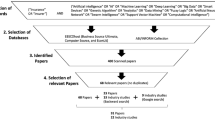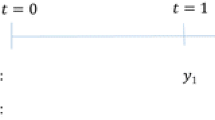Abstract
We consider a model of competitive insurance markets under asymmetric information with ambiguity-averse agents who maximize their maxmin expected utility. The interaction between asymmetric information and ambiguity aversion gives rise to some interesting results. First, for some parameter values, there exists a unique pooling equilibrium where both types of insurees buy full insurance. Second, in separating equilibria where the low risks are underinsured, their equilibrium contract involves more coverage than under standard expected utility. Finally, due to the endogeneity of commitment to the menus offered by insurers, our model has always an equilibrium which is unique (in terms of allocation) and interim incentive efficient (second-best).











Similar content being viewed by others
Notes
We have also examined the case of ambiguity-seeking agents. The main difference between the ambiguity aversion and the ambiguity-seeking cases is that in the latter case, in any separating equilibrium, no insuree (regardless of his risk type) buys full insurance. These results are available upon request.
We make this assumption to distinguish the effects of ambiguity from over-optimism or over-pessimism. However, this assumption rules out the following equilibria which are driven by over-optimism: (i) separating equilibria where no incentive compatibility constraint is binding (the equilibrium allocation coincides with that under full information); (ii) equilibria where none of the two types buys full insurance; (iii) separating equilibria exhibiting negative correlation between coverage and the accident probability (see Koufopoulos 2011).
We have also analyzed the case insurers are ambiguity averse, and most of the results are qualitatively similar except two main differences. First, ambiguity-averse insurers charge a higher per-unit price which reflects the ambiguity premium. Second, if the insurers’ degree of ambiguity is sufficiently high, the insurees are not willing to pay the high ambiguity premium the insurers charge and the insurance market collapses (no trade).
Our results would be qualitatively similar if the reference probabilities are different from the true ones. However, if the reference accident probabilities are lower than the true ones, the insurance companies should have some initial capital to fulfill their promises (cover their losses).
This assumption is made for simplicity and does not imply any loss of generality. Because there are only two types of insurees, all the results go through even if we allow menus to contain any finite number of contracts.
All the results go through if we allow insurers to commit only to one of the two contracts in a two-contract menu.
A similar argument applies if one type chooses underinsurance and the other overinsurance or both types choose overinsurance.
Unless the degree of risk aversion is infinite (Leontief preferences) in the standard expected utility framework or the perceived probabilities coincide in the case of over-optimism/pessimism (which is a zero-probability event).
Notice that if we employed the two-stage screening game widely used in applied theory papers (e.g., Rothschild and Stiglitz 1976), the nonexistence of equilibrium problem would arise in cases the Rothschild–Stiglitz separating allocation was not interim incentive efficient.
References
Bossaerts, P., Ghirardato, P., Guarnaschelli, S., Zame, W.: Ambiguity in asset markets: theory and experiment. Rev. Financ. Stud. 23(4), 1325–1359 (2010)
Condie, S., Ganguli, J.V.: Ambiguity and rational expectations equilibria. Rev. Econ. Stud. 78, 821–845 (2011a)
Condie, S., Ganguli, J.V.: Informational efficiency with ambiguous information. Econ. Theor. 48, 229–242 (2011b)
De Castro, L., Yannelis, N.: Uncertainty, efficiency and incentive compatibility. Working paper (2012)
Diasakos, T., Koufopoulos, K.: Efficient Nash equilibrium under adverse selection. Working paper (2013)
Epstein, L., Schneider, M.: Ambiguity and asset prices. Annu. Rev. Financ. Econ. 2, 315–346 (2010)
Etner, J., Jeleva, M., Tallon, J.M.: Decision theory under ambiguity. J. Econ. Surv. 26(2), 234–270 (2012)
Gilboa, I., Marinacci, M.: Ambiguity and the Bayesian paradigm. In: Acemoglu, D., Arellano, M., Dekel, E. (eds.) Advances in Economics and Econometrics: Theory and Applications. Tenth World Congress of the Econometric Society, Cambridge (2013)
Gilboa, I., Schmeidler, D.: Maxmin expected utility with non-unique prior. J. Math. Econ. 18, 141–153 (1989)
Holmström, B., Myerson, R.: Efficient and durable decision rules with incomplete information. Econometrica 51(6), 1799–1819 (1983)
Jeleva, M., Villeneuve, B.: Insurance contracts with imprecise probabilities and adverse selection. Econ. Theor. 23, 777–794 (2004)
Kajii, A., Ui, T.: Interim efficient allocations under uncertainty. J. Econ. Theory 144, 337–353 (2009)
Klibanoff, P., Marinacci, M., Mukerji, S.: A smooth model of decision making under ambiguity. Econometrica 73(6), 1849–1892 (2005)
Knight, F.: Risk, Uncertainty and Profit. Houghton Miffin, Boston (1921)
Koufopoulos, K.: Endogenous commitment and Nash equilibria in competitive markets with adverse selection. Working paper (2010)
Koufopoulos, K.: Asymmetric information, heterogeneity in risk perceptions and insurance: an explanation to a puzzle. Working paper (2011)
Koufopoulos, K., Kozhan, R.: Welfare-improving ambiguity in insurance markets with adverse selection. J. Econ. Theory 151, 551–560 (2014)
Maccheroni, F., Marinacci, M., Rustichini, A.: Ambiguity aversion, robustness, and the variational representation of preferences. Econometrica 74(6), 1447–1498 (2006)
Martins-da-Rocha, F.: Interim efficiency with MEU-preferences. J. Econ. Theory 145(5), 1987–2017 (2010)
Netzer, N., Scheuer, F.: A game theoretic foundation of competitive equilibria with adverse selection. Int. Econ. Rev. 55(2), 399–422 (2014)
Rothschild, M., Stiglitz, J.: Equilibrium in competitive insurance markets: an essay on the economics of imperfect information. Q. J. Econ. 90, 629–649 (1976)
Siniscalchi, M.: A behavioral characterization of plausible priors. J. Econ. Theory 128, 91–135 (2006)
Tallon, J.-M.: Asymmetric information, nonadditive expected utility, and the information revealed by prices: an example. Int. Econ. Rev. 39(2), 329–342 (1998)
Author information
Authors and Affiliations
Corresponding author
Rights and permissions
About this article
Cite this article
Koufopoulos, K., Kozhan, R. Optimal insurance under adverse selection and ambiguity aversion. Econ Theory 62, 659–687 (2016). https://doi.org/10.1007/s00199-015-0926-3
Received:
Accepted:
Published:
Issue Date:
DOI: https://doi.org/10.1007/s00199-015-0926-3




